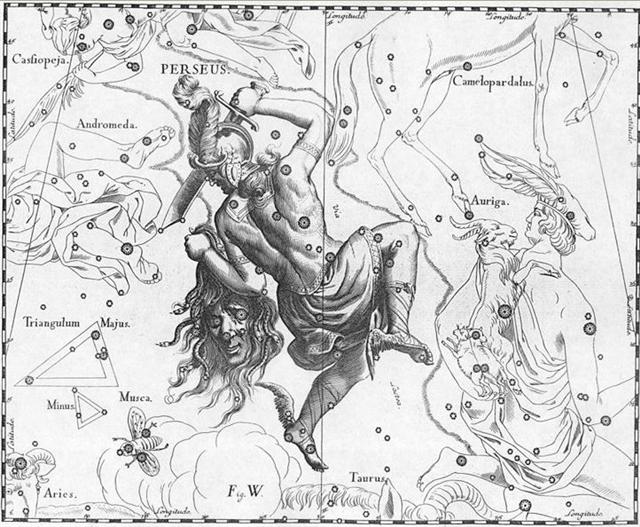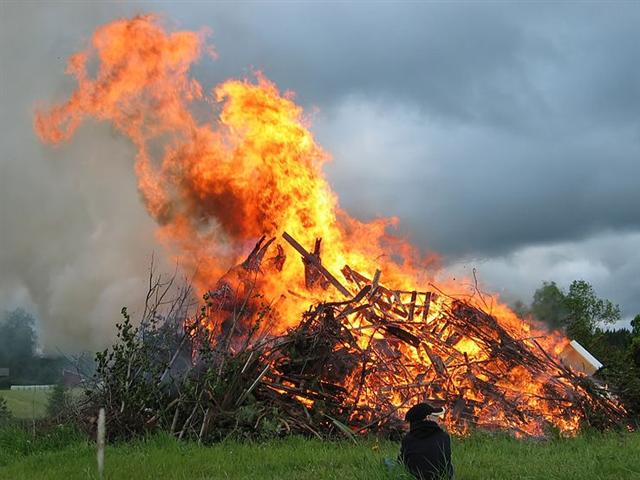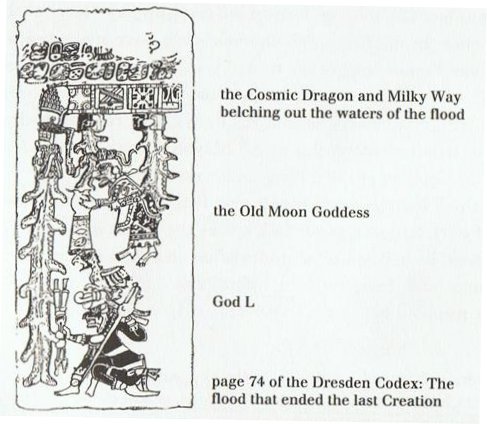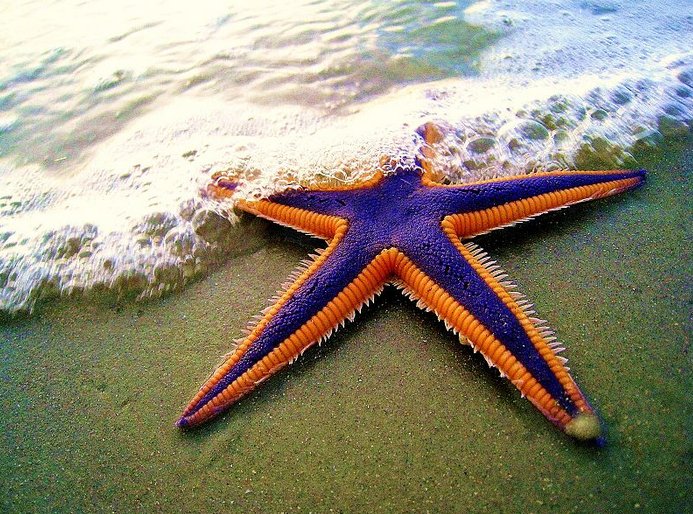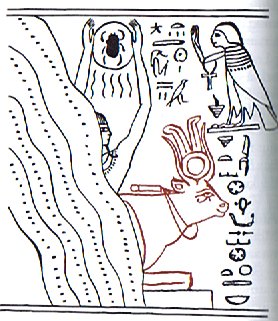At the time of Bharani spring equinox could have been thought of as the place where the Sun warrior Perseus rose with the severed head of the Medusa, viz. in "March 25. And this date could then have influenced Caesar to decide 'March 25 (rather than 'March 20 or 'March 14) should be the day for spring equinox in his calendar.
Gb8-12 is an example of my glyph type vero whích could have indicated the month when the cold winter ogre was 'killed by a spear':
... A vestige of the practice of putting the king to death at the end of a year's reign appears to have survived in the festival called Macahity, which used to be celebrated in Hawaii during the last month of the year. About a hundred years ago a Russian voyager described the custom as follows: 'The taboo Macahity is not unlike to our festival of Christmas. It continues a whole month, during which the people amuse themselves with dances, plays, and sham-fights of every kind. The king must open this festival wherever he is. On this occasion his majesty dresses himself in his richest cloak and helmet, and is paddled in a canoe along the shore, followed sometimes by many of his subjects. He embarks early, and must finish his excursion at sunrise. The strongest and most expert of the warriors is chosen to receive him on his landing. The warrior watches the canoe along the beach; and as soon as the king lands, and has thrown off his cloak, he darts his spear at him, from a distance of about thirty paces, and the king must either catch the spear in his hand, or suffer from it: there is no jesting in the business. Having caught it, he carries it under his arm, with the sharp end downwards, into the temple or heavoo. On his entrance, the assembled multitude begin their sham-fights, and immediately the air is obscured by clouds of spears, made for the occasion with blunted ends. Hamamea (the king) has been frequently advised to abolish this ridiculous ceremony, in which he risks his life every year; but to no effect. His answer always is, that he is as able to catch a spear as any one on the island is to throw it at him. During the Macahity, all punishments are remitted throughout the country; and no person can leave the place in which he commences these holidays, let the affair be ever so important ... At the time of Ain (or to be more precise, at the time of Hyadum II), 64 - 41 = 23 precessional days earlier than Bharani, the Sun would have been at Algol in MARCH 2 (61), and 80 days later, in MAY 21 (141), the Sun would have risen together with the star Bright Fire in Cancer. At the time of Bharani this happened 23 days later in the year, in "June 13 (164):
At the time of Bharani the Bright Fire had drifted ahead in the year and was no longer late in MAY but in the solstice month of "June. Its position in "June 13 could therefore have been contrasted with that in MAY 21 when anciently the Sun Fire had been highly potent instead of on its way to die out. By recalling the mythic time of the Bull for the tired old solstice Sun he might possibly find strength enough to revive. It was a time for Needfire: ... needfire ceremonies usually take place near the summer solstice (the Feast of St. John) ... but they occur in several other seasons as well. The summer date of the rite and its accompanying festival have to do, among other things, with fertility, as can can clearly be seen in a variant from the valley of the Moselle preserved for us by Jakob Grimm. Each household in the village was constrained to contribute a shock of straw to the nearby high place, Stromberg, where the males went at evening while the females went to a spring lower down on the slope. A huge wheel was wrapped with this straw. An axle run through the wheel served as the handles for those who were to guide it on its downward plunge. The mayor of a nearby town kindled the straw, for which office he was rewarded with a basketful of cherries. All the men kindled torches and some followed the burning orb as it was released downhill to shouts of joy. The women at the spring echoed these shouts as the wheel rushed by them. Often the fire went out of its own accord before it reached the river, but should the waters of the river extinguish it, an abundant vintage was forecast for that year ... Likewise should there have been need for a new fire at the opposite side of the year, at the other solstice in the month of "December. In the 14th century the Julian calendar had 'December 13 at the solstice, a fact which might have been noticed because in "December 13 the Bright Fire had been at the Full Moon: ... a discrepancy of 8 days would have been the case in the Julian calendar during the 14th century, resulting in Winter solstice falling on December 13. With the original adoption of the Gregorian calendar in the 16th century the discrepancy was 10 days and had increased to 11 days in the 18th century when Scandinavia adopted the new calendar, with Winter solstice falling on December 9 ...
Glyph 61 (possible to compare with the day number for MARCH 2) was, I suggest, meant to illustrate a newborn little henua (land) spewed out by a vae kore (no legs) creature:
Before coming down to Land (making Landfall) there was no need for legs, because for swimming in the Water fins were more useful: ... During his descent the ancestor still possessed the quality of a water spirit, and his body, though preserving its human appearance, owing to its being that of a regenerated man, was equipped with four flexible limbs like serpents after the pattern of the arms of the Great Nummo. The ground was rapidly approaching. The ancestor was still standing, his arms in front of him and the hammer and anvil hanging across his limbs. The shock of his final impact on the earth when he came to the end of the rainbow, scattered in a cloud of dust the animals, vegetables and men disposed on the steps. When calm was restored, the smith was still on the roof, standing erect facing towards the north, his tools still in the same position. But in the shock of landing the hammer and the anvil had broken his arms and legs at the level of elbows and knees, which he did not have before. He thus acquired the joints proper to the new human form, which was to spread over the earth and to devote itself to toil ... The figure stretching his neck in Ga3-2 could be pushing the roof of the sky high in order to let in more light and make Land reappear. It was the opposite of the time of Deluge:
The time for Drawing up Land in July 4 (185) = °June 30 (181) could have referred to the very ancient separation of Sky and Earth at the time of Gemini, which had been remembered at the time of Bharani as "May 24 (144 = 185 - 41). MAY 1, the corresponding date at the time of the Hyades Gate, would then have been 41 days after 0h, i.e. a number of precessional days which was the same as that down from the time of rongorongo to the time of Bharani: ... as soon as the sun rose above the horizon the writhing fish of Maui became solid underfoot, and could not be smoothed out again. This act of Maui's, that gave our people the land on which we live, was an event next in greatness to the separation of the Sky and Earth ...
At the time of Bharani the right foot of Pollux (ξ Gemini) had risen with the Sun in "May 24, when Pollux had got a secure foothold up on Dry Land:
This was the opposite side of the year compared to where Nunki (σ Sagittarii) marked the beginning of Water. ... This [σ] has been identified with Nunki of the Euphratean Tablet of the Thirty Stars, the Star of the Proclamation of the Sea, this Sea being the quarter occupied by Aquarius, Capricornus, Delphinus, Pisces, and Pisces Australis. It is the same space in the sky that Aratos designated as Water ... But the creator of the G text had evidently decided to put the origin in his calendar at the time when Sky and Earth were forcefully separated from their primeval embrace in Taurus. At the beginning of side a was day 1 after 0h and looking at Ga1-1 we can imagine the separation emerging from a single unit:
.. They were Ranginui, the Sky Father, and Papatuanuku, the Earth Mother, both sealed together in a close embrace. Crushed between the weight of their bodies were their many children, whose oppression deepened. They yearned to be free; they fought their parents and each other to break loose. Tuumatauenga, virile god of war, thrust and shouted; Tangaroa of the oceans whirled and surged; Tawhirirangimaatea ; Haumiatiketike and Rongomatane, of wild foods and cultivated crops tried their best but were not successful; and Ruamoko, god of earthquakes, yet to be born, struggled in the confinement of his mother's womb ... Of them all, Taane Mahuta, the god of the forests, was the most determined; he set his sturdy feet upon his father's chest, and braced his upper back and shoulders against the bosom of his mother. He pushed; and they parted. So the world; as the Maori understand it; came into being ... In the C text and 20 days later than in "May 24 (cfr Ga2-11) Metoro suggested the interpretation haka-peka-ga - the place for making a cross (†) - which possibly was referring to χ Cancri and alluding to blowing on the associated needfire (pekahi):
By connecting the key stars which where leading the spring Sun down towards Spica it could, though, have been necessary to go even further back in time, all the way down to when Gemini would have been at 0h. At this early beginning of time - when the Gemini twins went ashore - it ought also to have been a time for making a fire, for making a feast.
... Again they went on and reached Hanga Hoonu. They saw it, looked around, and gave the name 'Hanga Hoonu A Hau Maka'. On the same day, when they had reached the Bay of Turtles, they made camp and rested. They all saw the fish that were there, that were present in large numbers - Ah! Then they all went into the water, moved toward the shore, and threw the fish (with their hands) onto the dry land. There were great numbers (? ka-mea-ro) of fish. There were tutuhi, paparava, and tahe mata pukupuku. Those were the three kinds of fish. After they had thrown the fish on the beach, Ira said, 'Make a fire and prepare the fish!' When he saw that there was no fire, Ira said, 'One of you go and bring the fire from Hanga Te Pau!' One of the young men went to the fire, took the fire and provisions (from the boat), turned around, and went back to Hanga Hoonu. When he arrived there, he sat down. They prepared the fish in the fire on the flat rocks, cooked them, and ate until they were completely satisfied. Then they gave the name 'The rock, where (the fish) were prepared in the fire with makoi (fruit of Thespesia populnea?) belongs to Ira' (Te Papa Tunu Makoi A Ira). They remained in Hanga Hoonu for five days ... There were 3 days from Heap of Fuel to Bright Fire. Metoro seems to have indicated the Bay of Turtles (Haga Honu, Hanga Hoonu) at the honu glyph, i.e. at the Heap of Fuel star: haka-haga-na te honu (making it finally to here, the Turtle).
This was at Al Tarf (the End, β Cancri, cfr manu kake in Ga3-1) where a 'heart' could have been buried. ... The 7th Arab manzil Al Tarf was defined also from ξ Cancri (137.8), which fact is quite interesting, because also at that place in the G text a haú (binding) glyph was located. Viz. at a π glyph:
... Notably the star Al Tarf (the End, here for β Cancri) could have been used to integrate the cycle of Venus with the good (sa'ad) 'Navel' or 'Heart': ... In the center between Al Tarf and Al Sharas was right ascension day (124 + 168) / 2 = 146 = 292 / 2 = 584 / 4, where Ras Elaset Australis (the Southern Head of the Lion) rose with the Sun ...
... In the inscriptions of Dendera, published by Dümichen, the goddess Hathor is called 'lady of every joy'. For once, Dümichen adds: Literally ... 'the lady of every heart circuit'. This is not to say that the Egyptians had discovered the circulation of the blood. But the determinative sign for 'heart' often figures as the plumb bob at the end of a plumb line coming from a well-known astronomical or surveying device, the merkhet. Evidently, 'heart' is something very specific, as it were the 'center of gravity' ... See Aeg.Wb. 2, pp. 55f. for sign of the heart (ib) as expressing generally 'the middle, the center'. And this may lead in quite another direction. The Arabs preserved a name for Canopus - besides calling the star Kalb at-tai-man ('heart of the south') ... Suhail el-wezn, 'Canopus Ponderosus', the heavy-weighing Canopus, a name promptly declared meaningless by the experts, but which could well have belonged to an archaic system in which Canopus was the weight at the end of the plumb line, as befitted its important position as a heavy star at the South Pole of the 'waters below '.Here is a chain of inferences which might or might not be valid, but it is allowable to test it, and no inference at all would come from the 'lady of every joy'. The line seems to state that Hathor (= Hat Hor, 'House of Horus') 'rules' the revolution of a specific celestial body - whether or not Canopus is alluded to - or, if we can trust the translation 'every', the revolution of all celestial bodies. As concerns the identity of the ruling lady, the greater possibility speaks for Sirius, but Venus cannot be excluded; in Mexico, too, Venus is called 'heart of the earth'. The reader is invited to imagine for himself what many thousands of such pseudo-primitive or poetic interpretations must lead to: a disfigured interpretation of Egyptian intellectual life ...
|
||||||||||||||||||||||||||||||||||||||||||||||||||||||||||||||||||||||||||||||||||||||||||||||||||||||||||||||||||||||||||||||||||||||||||||||||||||||||||||||||||||||||||||||||||||||||||||||||||||||||||||||||||||||||||||||||||||||||||||||||||||||||||||||||||||||||||||||||||||||||||||||||||||||||||||||||||||||||||||||||||||||||||||||||||||||||||||||||||||||||||||||||||||||||||||||||||||||||||||||||||||||||||||||||||||||||||||||||||||||||||||||||||||||||||||||||||||||||||||||||||||||||||||
